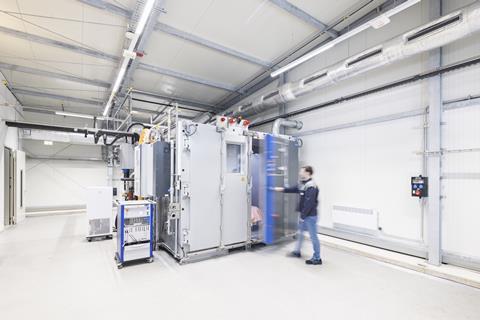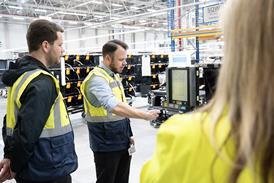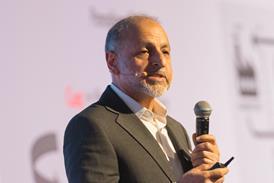Inside Henkel’s €130m ICD grounds, Henkel has been working on its state-of-the-art BEC, which includes the Battery Application Center (BAC), a lab enabling the application of Henkel technologies on serial battery pack size, and the Battery Test Center (BTC), a dedicated state-of-the-art lab to test loaded batteries to all known industry standards.

The facilities have been designed to foster collaborative development of next-generation EV battery solutions, with a growing team of engineers and researchers coming together under one roof to focus on pivotal innovation areas across safety, sustainability, thermal management, and battery design and cell technology.
From supplier to EV battery design partner
With the new facilities and the shift towards electrification comes a rebirth of Henkel Automotive’s function within the automotive manufacturing sector, evolving from being perceived as only a tier supplier for OEMs and battery manufacturers, to being seen as the battery design and innovation partner that Henkel is.
Watch: AMS visits Henkel’s Battery Engineering Center in Düsseldorf
“As a whole, the ICD has this idea to invite and embrace collaboration with partners and customers and jointly find a solution,” Stephan Hoefer, global market strategy head of E-Mobility at Henkel tells AMS. As he takes AMS on the first tour of the labs, he adds: “I think that is apparent in the way we are investing into this center, into our capabilities, and it underlines our commitment to being a thought leader and eye level partner with our customers. We want to co-create and co- develop, not just only a material supplier.”
This ability to be a co-developer lies partly in the proximity of the BAC and BTC. “Henkel has been in the industry for decades, but everything has changed with e-mobility, development needs to go fast, decisions are revised, and engineering is done iteratively. One of the most important things we have identified when it comes to collaboration is the importance of speed,” says Hoefer.
When working with an OEM or battery manufacturer, Henkel can invite them to bring their battery prototype to the ICD and optimise the battery inhouse. With digital twins and software-based modelling and simulation, the impact of different materials to the total system can be predicted. Based on this data, Henkel can apply an existing material or run a quick sample based on the defined parameters and apply the corresponding material to the customer part in the BAC, quickly adjusting using Henkel’s in-lab six-axis robot which can change dispenser units and applicators. Afterwards, a physical testing of the prototype using a climate testing chamber can prove the total system performance based on all existing industry standards. This is a unique setup in the e-Mobility industry.

Marco Dinninghoff, senior sales manager, E-Mobility at Henkel agrees that speed is becoming increasingly important in the shift to EVs. “OEMs, tier ones and battery manufacturers are accelerating their development cycles to be competitive and have a shorter time to market to meet the end customers’ demands,” Dinninghoff tells AMS. “We address this here in the BEC by combining capabilities in simulation, with automated application of our materials and a full-scale battery testing and validation for battery systems. I think the capability for simulation is one of the most important things that has the potential to speed up innovation cycles.”
Despite a slight slowdown in battery EV demand, Dinninghoff says BEVs currently have a market share of 14.5% in Europe, which is the point where it is about to jump to mass market. He says the slowdown is an expected phase in the lifecycle of new technologies, but that speedy development is necessary now to convince the masses of the performance and reliability of the product. Combining digital simulation with real-life application and testing allows Henkel and the client to optimise the performance of materials in battery prototypes while also reducing the time and cost spent in validating those technologies and changes.
Inside Henkel’s Battery Application Center (BAC)

The BAC was built so that Henkel would have a space where all its products could be applied to EV battery prototypes directly and in all varieties. It has the capacity to handle large battery casings and apply materials, including thermal interface materials, battery safety materials, adhesives and sealants, to the battery using the robotics system.
Dr. Olaf Lammerschop, global technology lead, E-Mobility at Henkel explains how engineers in the BAC work with customers while showing AMS around the lab. “The benefit is that we can use experimental materials from the lab and create a full application data set with those experimental materials, which saves a lot of time and is super flexible,” he says. “Our customers can try it together with us, try out how the application works and what needs to be optimised, if we need to apply materials faster or apply more or less pressure, and see if we need to exchange the mixers or change the product a little bit. This can all be done here. And then the customers can take away the full data package and have the confidence that this material also works in serial production. We want to replicate that process as close as possible in production so that there are no hiccups later.”

This process wasn’t possible before the creation of the BEC. Now, Henkel can apply a multitude of products in-house to customers’ prototypes, and vary volume, application and dispensers easily and quickly. “We can get material from the product development lab nearby and bring it in here and create the full application data package,” Lammerschop says.
Testing EV battery prototypes in Henkel’s Battery Test Center (BTC)
After simulations using the digital twin and application in the BAC, clients can then test the battery prototype under varying conditions in the BTC, using Henkel’s battery test rig and climate chamber. The chamber is big enough to easily fit a full EV battery pack. The battery pack can be connected to the 330KW power supply to simulate driving performance, fast charging and battery aging, and fully test the electrical performance and sealing of the battery. The chamber can perform various stress tests through temperature cycling, which can be varied from -40 degrees Celsius to 90 degrees Celsius, and humidity can also be controlled, ranging from 10- 90% relative humidity.
Henkel also has a leakage tester, which puts pressure on the battery to detect any leaks and simulate how the battery might react in a crash. Everything in the BTC allows Henkel to really test and validate varying driving and storage conditions that the EV battery will be put through across its entire life cycle.
“The battery test center is a co-creation space, where we are working together with our customers to analyse and optimise the customers battery pack performance from a thermal management as well as structural side,” says Lammerschop.
Safety inside the Battery Test Center

Lammerschop explains that the BTC has multiple safety features, including sensors that can detect smoke, carbon monoxide and organic gases. Inside the climate chamber, the battery pack is connected to cooling liquid, and in the case of a fire, a sprinkler system will help extinguish the battery and the chamber will automatically shut down fully to prevent any further damage.
In the case of thermal runaway occurring in the battery, which is a chain reaction that cannot be easily stopped, Henkel has access to the 24/7 fire department nearby on campus, which can connect fire hoses to the chamber and flood the battery, ensuring it cools underwater.
Ensuring confidential protection of battery prototypes
Of course, on top of ensuring safety within the BEC, Henkel must equally ensure confidentiality when working with OEMs and battery manufacturers on commercially sensitive EV battery prototypes.

Dinninghoff says confidentiality is a “foundation” at Henkel. “If you work with prototypes and sensitive information, it’s of course very important to handle that adequately,” Dinninghoff says. “Before we start working on new projects with OEMs or battery manufacturers, we set up a legal framework, we sign non-disclosure agreements (NDAs) with clearly defined parameters about what can be shared and what can’t.”
The premises are also TISAX certified, meeting the automotive industry’s global standard of information security assessments. “This means we need to comply with strict guidelines for data protection. To make sure that this happens, we run through regular audits with customers and third parties regularly,” he adds.
Henkel’s future as a BEV co-developer
While work within the BEC in Düsseldorf has just begun, Henkel is already planning on expanding its innovative facilities further.
“Right now, we are about to open the Inspiration Center Shanghai in the next year to address the Asia Pacific market,” says Hoefer. Henkel is also planning to expand its network of battery facilities with the opening of new battery centers in China and the US in the coming years, solidifying its position as a leading global e-mobility design and innovation partner.
“So, let’s take this as a starting point that we are going to then grow across the other regions as well, to ensure that we are serving our customers around the globe,” Hoefer adds.
Click for more information on Henkel’s automotive and EV offerings here, and its Battery Engineering Center here.
Topics
- Battery Cell and Gigafactories
- Battery recycling
- Battery System and Pack Production
- Connected Manufacturing
- Design for Manufacturing
- Digital Tools
- Digital Twin
- Digitalisation
- Digitalisation and Automation
- Electrification
- Europe
- EV manufacturing
- Factory Investment
- Henkel
- Manufacturing engineering
- Powertrain
- Powertrain
- Recycling
- Smart Factory
- Tier suppliers












































